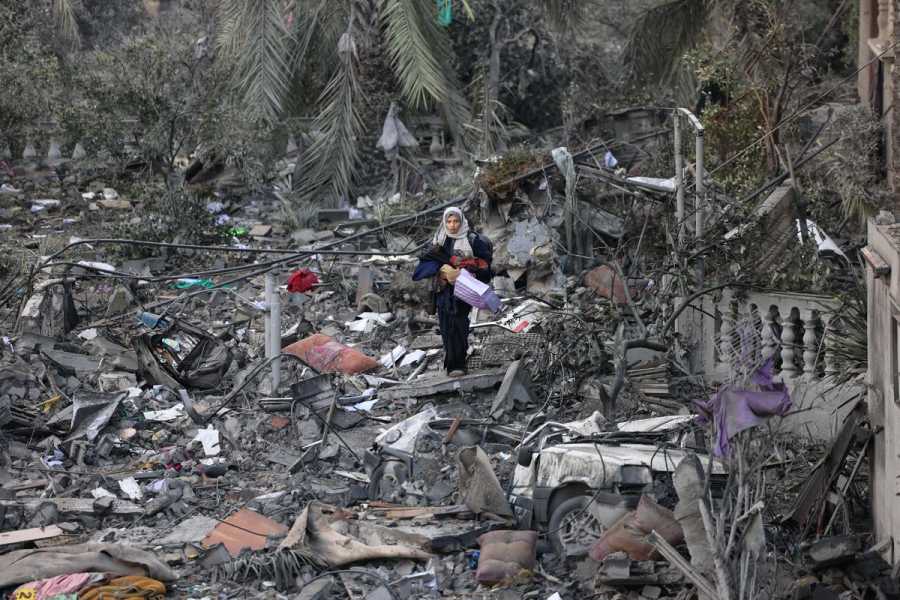Here’s what the reported hostage deal does — and doesn’t — mean for war in Gaza.

A Demonstration to bring the Israeli hostages held in Gaza by Hamas back home, organized by the Hostages and Missing Families Forum. Faiz Abu Rmeleh/Middle East Images/AFP via Getty Images Jonathan Guyer covers foreign policy, national security, and global affairs for Vox. From 2019 to 2021, he worked at the American Prospect, where as managing editor he reported on Biden’s and Trump’s foreign policy teams.
On Tuesday, the Israeli government reportedly approved a deal with Hamas that the state of Qatar brokered and that has been more than a month in the making.
The final deal has yet to be officially announced, but the rough outlines reported in the media throughout Tuesday include several key planks: Hamas would exchange 50 hostages — women and children who are Israeli and dual-national — with Israel for about 150 Palestinian prisoners currently held in custody, mostly women. If all goes to plan, Israel would commence a four-day ceasefire in Gaza and would also stop drone overflights for six hours a day. After those days, the ceasefire could be extended a day with each additional 10 or 20 hostages Hamas releases, though the details are a bit different in each news report. During this period, Israel would not allow Palestinians to return to northern Gaza, but would allow some 300 trucks of aid in daily, including fuel.
This is a deal that has essentially been on the table for about a month, and according to the Guardian, negotiations were already happening before Israel launched its ground attacks on Gaza. Israel had defined its twin objectives as eliminating Hamas and bringing the hostages back, but experts noted that the former had been the priority until political dynamics led to an increased willingness among Israeli leadership to accept a truce to bring some hostages home. “Public pressure led Netanyahu to agree to a deal that he refused until now,” wrote journalist Yossi Verter in Haaretz’s Hebrew edition.
The deal itself would be neither a resolution to the war nor to the roots of the conflict between Israel and Palestine. It’s a significant development that’s better than nothing, but it’s not a long-term solution.
[Related: Everything you need to know about Israel-Palestine]
When Hamas conducted its October 7 attack and took about 240 Israeli, dual-national, and international people hostage, Israel’s security outlook changed. Its drive to pursue a destructive military campaign in Gaza is based in a desire to “destroy Hamas.” But, as US and Arab officials acknowledged at an international summit over the weekend, there is no plan for Gaza the day after, or even now. Israel’s lack of strategy or goals in its response to the Hamas attack of October 7 has led to a situation where Israel’s ongoing military operations risk becoming a forever war just like America’s over the last two decades.
At the same time, Palestinians in Gaza are suffering most. Al Jazeera has reported that there are no functioning hospitals in the northern part of occupied territory, in large part due to Israeli military incursions and a lack of fuel, and that the remaining 21 of Gaza’s 35 hospitals are “completely out of service.” In the lead-up to the announcement of a ceasefire, Israel’s attacks on Gaza continued.
If this deal is confirmed, it is a diplomatic achievement, to be sure, but it’s only the beginning of a set of complex negotiations that will be needed to address the ongoing war, the humanitarian crisis facing Palestinians in Gaza, and the potential for the war to extend to the broader Middle East.
Why is there a deal now?
For weeks, Qatar, with US buy-in, has been helping facilitate negotiations between Israel and Hamas over a deal somewhat along the lines of today’s. But the experts I’ve spoken to in recent weeks had reservations. The skepticism was not around the need for the talks or their import, but more about their fragility; these deals are only real once they’re announced, and even then they are tenuous. (At least once over the last week, media reports indicated a deal was imminent, only for those assertions to be walked back.)
But this evening, Netanyahu endorsed the deal and pushed his government’s ministers to accept it. “Tonight we stand before a difficult decision, but it is the right decision. All security organizations support it fully,” he told Israeli television. The White House has maintained that the deal was “close” but President Joe Biden wouldn’t go into further detail. On Tuesday evening, the deal’s announcement appeared imminent, and likely to come from the Qatari government if and when all parties agreed.
A combination of Qatar’s orchestration of the deal, Israeli internal political pressure on Netanyahu, and Hamas’s commitment to getting the release of Palestinian prisoners has contributed to this truce and exchange.
Some secrecy is required for such a deal to work, but that can also work to its detriment. Analysts speculate, for example, that Hamas would treat the exchange of Israeli civilians differently than it would Israeli soldiers.
In the past, Israel has been willing to exchange many Palestinians for its soldiers: Yahya Sinwar, the Hamas leader, was released from an Israeli prison as part of the 2011 deal for the Israeli soldier that released 1,000 Palestinians, for example. “We will not forget our prisoners who we left behind,” Sinwar said upon his release.
The terms are not likely to be made public in full, and there aren’t really any enforcement mechanisms. “It’s hard to tell when an agreement was violated, who violated it, and then how we can kind of get back to some sort of ceasefire agreement,” Yousef Munayyer, a researcher at the Arab Center in Washington, DC, told me. “This is something that’s played out between Israel and Hamas a lot, going back to 2008. So one of my concerns is like, what are the exact terms of this agreement? And are both sides publicly committing to the same terms?”
Israelis will have 24 hours to appeal any deal to the Supreme Court, according to the country’s national security adviser.

Personal items from the Nova music festival site that have been put on display for family and relatives to collect at the Kochav HaYam complex on November 19, 2023, in Caesarea, Israel. Christopher Furlong/Getty Images
One reason Israel has agreed to the deal now is the growing advocacy from the families of hostages. “The government is in complete disarray,” Mairav Zonszein, an analyst with the International Crisis Group, told me. “In the first few weeks of this, the hostages were like an afterthought, they were not the priority. That’s a huge shift that happened in the last few weeks, where the families after the initial shock started to organize themselves and they basically put it on the agenda.”
As the families became more and more organized and more agitated, they became more convinced that the Israeli government was avoiding doing the deal. Their slogan became “Deal Now!” These demands didn’t just exert pressure on Netanyahu’s government, but on him individually — calling into question his longtime framing of himself as Mr. Security, at a moment when he’s extremely politically vulnerable.
Israel has perhaps also made a strategic calculation that its military campaign of 46 days had shown it was serious about its objective of eliminating Hamas. However impossible experts say that it might be to decimate a militant group that’s part of a broader social and political organization, Israel didn’t want to look as though they were compromising from a position of weakness. “For the Israelis, politically, I don’t think they were going to be prepared to accept any sort of exchange on October 8,” Munayyer explained. “They first wanted to do some damage. They first wanted to make it feel like they were imposing a price on Hamas before they made any sort of agreement, even though it was likely that an agreement was inevitable at some point.”
Though Israel still sees negotiations as a defeat or a concession, it’s really the only path to future peace and security for the region.
The future of Gaza is unclear
Whatever the shape of the deal, the question looms of what happens next to Gaza.
In the short term, more suffering seems clear. Netanyahu has pledged to continue military operations in Gaza after the five-day pause. “The war has its stages, and the release of the hostages has its stages as well. But we won’t rest until we achieve total victory, and until we bring everyone back,” he said in the televised remarks.
There also is no ceasefire or pause negotiated on Israel’s northern border with Lebanon, where Hezbollah and Israel have been trading strikes.

A Palestinian woman walks on building rubble following an Israeli strike in Rafah in the southern Gaza Strip on November 20, 2023, amid ongoing battles between Israel and the Palestinian Hamas movement. Said Khatib/AFP via Getty Images
And longer term, what came out of last week’s summit of Middle East leaders in Manama, Bahrain, is that there is no plan, no commitment, no interest. “After two days of talking to officials about the plan for post-war Gaza, the inescapable conclusion is that there is no plan. The shattered enclave will need external help to provide security, reconstruction and basic services,” the Economist reported. “But no one—not Israel, not America, not Arab states or Palestinian leaders—wants to take responsibility for it.”
And it’s easy for Biden’s people to talk about a two-state solution, as we’ve seen in their talking points in recent days. The Israeli military operation will only go so far in achieving its goals. There will need to be a bigger political agreement to the ongoing Israel-Hamas war. Its core concerns won’t be solved militarily, as the hostage exchange deal makes clear. “You need a political path,” Ezzedine Choukri Fishere, a former Egyptian diplomat now at Dartmouth College, told me recently. “If this is only talk as it has been over the last few decades, then the outcome will be the same”: a frozen peace process that has gone nowhere.
Like this exchange, such an over-the-horizon conversation about what happens to Gaza and the future of Palestinians is going to require engaging indirectly with Hamas. “The stated goal of destroying Hamas is not achievable,” Khaled Elgindy, a researcher with the Middle East Institute, told me last month. “So how do you even know when you’ve gotten to the day after?” That’s not exactly popular to hear.
One thing to watch is whether more Western countries and organizations call for a ceasefire. Though the French president, the United Nations, and leading humanitarian groups have urged one, other countries have rejected these calls. This pause may lead others to join the group. And that may ultimately put pressure on the Biden administration and other leaders. “The idea is that you need to stop the killing in order to figure out how you can build on that, how you can try to figure out alternatives to the fighting,” Zonszein told me.
Right now, Gaza needs aid. The 300 trucks that US humanitarian envoy David Satterfield briefed journalists about today won’t be enough, and Israel has restricted movement within Gaza. The UN notes that there still isn’t electricity in Gaza, hospitals face severe shortages, and Israel has not allowed food shipments to enter northern Gaza. According to the latest data from the Gaza Ministry of Health, more than 14,000 Palestinians have been killed since October 7, over half of whom are women and children, and 1.7 million people have been internally displaced. The situation in Gaza is beyond dire, with 53 journalists reportedly killed in Israeli strikes and more than 100 United Nations officials killed. The World Health Organization described al-Shifa Hospital as a “death zone.”
At the same time, militant groups with links to Iran are attacking US military installations in Iraq, Syria, and off the coast of Yemen. The risks of this war expanding and drawing the US into a more direct role endure.
The truce represents a major breakthrough after six weeks of war between Israel and Hamas, but the bigger takeaway is clear: More diplomacy is needed now. Five days of pause isn’t enough.
Sourse: vox.com